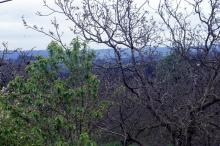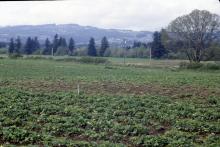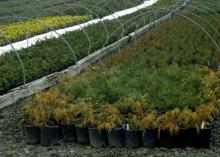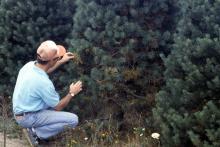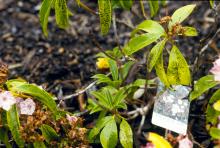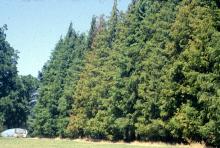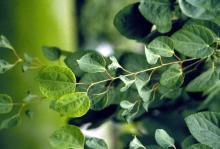Someone who has a plant problem asks two questions: What is the problem, and how do I correct it? These are hard questions for beginners and experts alike. Diagnosis is the process of determining the cause of a problem. It can be a long or short process depending on one’s ability, experience, and the nature of the problem. Once the cause is known, an appropriate management strategy can be developed.
Disease Diagnosis
Plant pathologists take many different approaches to diagnosing plant disease problems. The first step is to decide whether the problem is a plant disease. The broadest definition of plant disease includes anything that adversely affects plant health. This definition can include such factors as nutrient deficiencies, lawnmower damage, air pollution, and pathogens. A stricter definition usually includes a persistent irritation resulting in plant damage. This excludes mechanical damage such as lawnmower injury to trees or natural events such as hail or lightning. A very strict definition includes only those (living) things that replicate themselves and spread to adjacent plants. This includes such biological organisms as nematodes, fungi, bacteria, and viruses. Plants damaged by macroscopic organisms, such as deer, rodents, and birds usually are not considered to be diseased.
Many people use the picture-book method of diagnosis: looking at textbook pictures of problems and attempting to match the problem with the picture. “The Ortho Problem Solver” and the APS Plant Disease Compendia series are examples of texts that have many useful, high-quality color pictures. Although this method is useful for simple and common problems, it is usually inefficient and inaccurate for more complex or difficult situations.
Another simple technique, used by “The Ortho Problem Solver,” is the checklist. Through a series of 70 questions, a person builds a case history of the problem. The questions include the kind, age, and size of the plant. The plant’s location, location of the property, and relationship to other plants also are part of the checklist. Information on the recent weather and soil conditions, soil coverings, and recent care also are needed. Describing the overall condition of the plant is very important.
The checklist approach is a good guide for the types of questions to ask, but not all the questions are necessary. Some pertain only to certain situations or plants. Other approaches to disease diagnosis attempt to narrow the possibilities with each question and are like synoptic or dichotomous keys.
The diagnostic keys differ depending on the author. Some keys start by identifying the part of the plant that is affected. Is it the whole plant, or just the leaves, branches, stems, or roots? Some refine the first questions to stages of the plant; for example, are the seedlings, flowers, fruit, or seed affected? Some diseases affect only certain portions of a plant. Many other references start out with the plant itself: is it a cherry tree, foliage plant, or zinnia? Only a limited number of diseases attack a given plant species.
There is no one key set of questions or techniques for diagnosing plant diseases. Experience and practice are the best teachers. It is easier to diagnose plant problems by making a personal, on-site inspection. Subtle influences of the site, plant environment, and possible management practices can be seen that may have been overlooked by the grower. Difficulties arise when the diagnostician is presented only a portion of the plant because that portion may or may not indicate the real problem. The worst situation is a request for a diagnosis by phone, because misunderstandings and an inaccurate diagnosis can easily occur. However, sometimes this is the only contact someone may have with a diagnostician.
The Systematic Approach
To organize your approach to a plant disease problem, the “Systematic approach to diagnosing plant damage” by J. L. Green, O. Maloy, and J. Capizzi is useful and is presented briefly here. The approach involves defining the real problem and distinguishing between living and nonliving causes of plant damage by looking for patterns, determining the development of the damage, and building a case history of the problem. With these steps, you can quickly narrow the possibilities and to turn to appropriate reference materials including textbooks, herbarium samples, and knowledgeable specialists.
Define the Real Problem
Identify the plant and what it should look like at this time of year. A grower or gardener may mistake a normal stage of development for a diseased plant. Although a plant may exhibit symptoms of wilting, the real problem may be due to rotted roots, a girdled trunk, or lack of water. Determine what part(s) of the plant is/are affected.
Look for Symptoms and Signs
Symptoms and signs are used to describe the problem and diagnose the condition of a plant.
Symptoms are the physical characteristics of disease expressed by the plant. Symptoms can include the following: Blight, Blotch, Burn, Canker, Chlorosis, Curl, Dieback, Dwarfing, Epinasty, Etolation, Fasciation, Gall, Mosaic, Mottle, Necrosis, Phyllody, Ringspot, Rot, Scorch, Stunted, Water Soaked, Wilt, Witches Broom, and/or Yellowing. Definitions of these can be found in the glossary.
Signs are physical evidence of the pathogen, insect or biotic factor causing the disease. Signs can include fungal fruiting bodies, dispersal or survival structures (such as acervuli, conidia, mushrooms, pycnidia, sclerotia, rhizomorphs), mycelia, presence of nematodes or insects, cast skins, or the presence of insect holes accompanied by frass. Again, these terms are defined in the glossary.
Start with a general examination of the plant or plant part. It is not necessary to get into minute details at this point. Later in the process, once you have specific symptoms or signs to look for, you can always come back to the sample.
Look for Uniform or Nonuniform Patterns
Uniform damage is indicative of nonliving, abiotic factors, while nonuniform damage to plants is indicative of living, biotic factors. Uniform damage may occur on many plant species in the same area, on all the plants in a particular row or block, on all the leaves or shoots on one side of the plant, or on the same-age portion of each leaf or needle. Nonuniform damage shows up as scattered affected plants among a community of plants, scattered leaves or shoots on a single plant, or scattered spots on a single leaf. In earlier versions of this technique we described this as uniform vs random patterns. The idea is something opposite of uniform and not a statistically random pattern, which is why it was changed to nonuniform. An efficient diagnosis looks for patterns first in the plant community, then on individual plants and finally on plant parts.
Plant Community
The plant community typically is defined as all of the same plants in the same field. But you need to think outside the box (field) and examine other plants in the area. The plant community can also be defined as ALL plants in that area including weeds, other fields of other crops, and/or plants in a nearby riparian area.
Consider herbicide drift from a nearby planting or riparian area. If you were only focused on the field in question you would never realize the scope of the problem. The distribution of damaged plants may initially look random until you key in on the pattern with more damaged plants occurring the closer you get to the area of application. You would also realize that the damage was not restricted to one field alone.
Starting with the plant community can help you get to the cause of the damage faster, especially for nonliving problems. Environmental injury such as too cold or too hot, not enough chilling, uneven ripening due to temperature fluctuations, and storm damage will generally affect many plants on a wide scale. Soil related conditions such as pH, deficient or toxic fertility, salt toxicity, residual fumigants, etc. will affect most of the plants in a single field. Grower management tactics applied throughout the field can also result in a uniform pattern including the misapplication of growth regulators or phytotoxic pesticides.
In addition, if the problem is indeed a plant pathogen, then you are confirming that other plants are not necessarily damaged and that the pattern is nonuniform.
Problems due to insects, fungi, nematodes, bacteria, and viruses typically do not initially result in damage to every plant. Red stele of strawberry is a problem where soil moisture is high such in swales or draws where water runs or collects. Nematode related problems generally occur in circular or oval patterns within a field. Thrips and/or mite damage can occur on scattered single plants in an otherwise healthy field. A common mystery to producers is why one plant looks perfectly healthy but right next to a plant that is clearly diseased.
Examining the plant community first can be difficult in the field when producers take you to a certain location but expect you to start examining an individual plant right away. You can observe the community around you as you are led into the field. An examination of the community may be impossible for laboratory diagnosticians as you generally only get plant parts. It is critically important to ask questions about the plant community so you can proceed to the next step if needed.
Individual Plants
After looking for patterns in the community, look for patterns on individual plants. A thorough and systematic examination of plants is important. In the field, start with the top of the plant and proceed to the root crown and then the roots. If it is just an aboveground problem, there may be no need to dig up the plant. Look at several plants from different locations to find a consistent set of symptoms and/or signs.
Dig plants carefully so you do not miss any subtle issues. Ignore people that want to grab the plant and do “tug” or “wiggle” tests. Just pulling a plant straight out of the ground may leave the evidence of specific root problems behind in the soil. Digging may also reveal soil conditions such as hard pans, poor water drainage, damaged drip lines, gophers, etc. that are not as apparent from aboveground. You may also find unusual and strange things that are hard to anticipate such as burlap sacks or planting trays not being removed.
Shallow cuts with a sharp pocket knife can be very informative about the conditions of various tissues. You are generally looking for a transition from diseased to healthy tissues. Is necrosis coming from the top working down into the root crown or from the roots up into the stem or directly into the trunk itself? Make cuts carefully and examine them right away. For example, strawberry tissue exposed to the air will oxidize rapidly and may turn pink to dark-red within minutes. Red stele turns the central portion of roots a dark-red color but so will exposing a healthy central root core to air for several minutes.
If you are not familiar with the plant or certain cultivars, dig up a few healthy plants (with the permission of the producer). Cut into the various tissues to see what they are supposed to look like. Then you can properly asses the condition of diseased plants.
In the diagnostic lab, start with the roots, then the root crown, and then to aboveground tissues. If it is a root problem there is little need to fully examine the top of the plants as you know it will have nonspecific symptoms.
As you did in the community, you are looking for uniform patterns (or lack thereof) such as damage to specific age class of leaves, fruit or roots, certain sides of the plant such as north or south, and/or tissues located in certain parts of a raised bed.
Plant Parts
Jumping right to plant parts first might send you off in the wrong direction for a diagnosis. Finding uniform damage in the community and individual plant may or may not be seen as uniform damage on plant parts. Herbicide drift or pesticide toxicity might look like a fungal leaf spot at first. Necrotic injury due to sprays may show a uniform distribution on the leaf while fungal leaf spots will be more random. Damage to fruit might be uniformly seen only at the tip (calxy end) or on the shoulders (stem end). Leaves may have necrosis only along the margins or serrated tips. All root tips may all be decayed or nonexistent. Uniformity may be subtle such as damage only on shaded or exposed fruit.
Looking for signs of diseases or insects is important at this point in the process. Fungal fruiting bodies or sporulation might have occurred in the damaged area. Bacterial ooze, root knots, cast skins, frass, or the insect or mite itself as well as fungal structures might all be visible with even minor magnification. Knowledge and experience will help you separate opportunistic organisms from primary pathogens.
At all levels, determining patterns will get you pointed in the right direction. Separating abioitc from biotic factors eliminates half of all the problems. You can begin to ask the right questions and get much closer to the correct diagnosis.
Determine the Time Development of the Damage
There are exceptions to all the rules. Factors may be so conducive to disease or insect development that they may be found uniformly throughout the field. Time is the missing element in these cases. If you were in the field at the start of the epidemic you would have found a nonuniform distribution. But after many cycles of a multicyclic disease such as powdery mildew you would find it uniformly on all plants. Spread of damage from plant-to-plant or to other plant parts over time indicates damage by a living organism.
On the other hand, if the damage does not spread or there is a clear line of demarcation between damaged and nondamaged tissues, this is indicative of abioic, nonliving factors. Frost damage to a field may occur in pockets or low areas of a field. The plants will be affected all at once, literally overnight.
You may not be present when the abiotic factor occurs but understanding the growth and development of the plant can help you determine these problems. Environmental factors may damage exposed juvenile plant parts at the time of the event. Finding patterns where only certain age classes of leaves or fruit or even roots may help indicated these nonliving factors.
Continue the Investigaton
How you proceed from here will depend on what you have found and observed with the preceding steps. In the field you may not get much farther down the diagnostic path. But you can develop important questions for the producer to think about and answer especially for abiotic problems. You may be able to suggest general management tactics that can be taken while you continue the diagnostic process with a laboratory. Just as important you may be able to eliminate certain costly and ineffective management tactics. If the problem is abiotic then most pesticides will not correct the problem.
Once you have determined that a real problem exists and is caused by a living organism, you need to decide what type of organism may be causing the damage. There are many fungal and viral diseases of plants and a few caused by bacteria and nematodes. Some insect problems can mimic diseases; however, this next discussion will focus only on pathogens.
“Preliminary Diagnosis of Plant Diseases by Visual Symptoms” by C. Leach is a useful article; it is briefly described here. The discussion focuses on biological causes and also discusses many physical factors such as extremes in environment.
Begin by establishing which plant part or growth stage is showing symptoms. Are symptoms showing on roots, tubers, bulbs, corms, seedling, foliage, stem, branches, trunks, flowers, fruit, or on the entire plant? Often, you must next decide whether the symptoms are on the outside of the plant or whether you need to cut into it to see the symptoms.
Leaf (and Petiole) Symptoms
Dead areas on leaves can be caused by fungi or bacteria. Lesions bounded by small leaf veins are characteristic of bacterial angular leaf spot but could be confused with fungal leaf spots in later stages of the disease. Necrotic areas caused by bacteria may be distinguished by water-soaked margins or bacterial streaming. Necrotic areas caused by fungi may contain hyphae, distinctive spores, or fruiting bodies. Incubation in a warm, moist environment such as an enclosed plastic bag with a damp paper towel can encourage fungal development. Observation of the tissue must happen within 24 hours as secondary organisms will grow quickly as well. A moldy-white appearance of leaves without necrosis can indicate powdery mildew. Although small rusty red, brown, or black spots may be caused by rust or smut fungi. Discoloration (yellowing or shades of green), which is localized or in distinct patterns, usually indicates a virus. Leaf distortion (elongated, dwarfed, etc.) can be caused by several viruses. Leaf galls usually are caused by fungi, such as peach leaf curl or azalea leaf gall. Viruses and nematodes rarely cause galls on the leaf.
Wilting indicates lack of water, which may be due to one of the vascular wilt fungi, root rots, or bacterial wilts. General yellowing or reddening, stunting, or sudden collapse may indicate either a root rot (covered below) or systemic viral infection. Other parts may need to be examined for an accurate diagnosis.
Flower Symptomes
Abnormal color changes and/or distortions can be caused by several viruses. Partial or complete death of flower parts can be caused by fungi and bacteria. Fungi usually produce characteristic spores; bacterial infections can appear water-soaked. Smut of grasses convert individual flowers or whole inflorescences into masses of black spores. Ergot, stamen blight of blackberry, and anther mold of red clover are other fungal examples of converted flower parts. Some nematodes also can convert flower parts for their own use.
Fruit Symptoms
Fungi cause a wide variety of decays, rots, and superficial spotting or russetting. Important symptoms include specific color of rotted tissue, firmness of the tissue, and signs such as spores or spore-bearing structures. Viruses can cause discolorations and malformations. Bacteria may cause discrete spots on fruit in certain field situations or soft rots in storage.
Stem, Branch, and Trunk Disorders
The leaf disease remarks above pertain to most stem disorders of annuals or herbaceous perennials. Complete or partial death of woody stems or branches, usually referred to as cankers, can be caused by a large variety of fungi and a few bacteria. Cutting into the wood with a knife may reveal a sharp border between healthy and infected tissue. Look for spore-bearing structures of fungi or induce sporulation in a moist chamber. Some bacterial cankers will excrete a sticky ooze in the spring. Wood rots and decays are caused mainly by fungi, which may produce large conks or bracket-like fruiting structures. Galling can be produced by the crown gall bacterium Agrobacterium tumefaciens. A few galls or swellings are caused by fungi, such as white pine blister rust and Exobasidium spp. Witches’ brooms (excessive branching) can be caused by several fungi and by a group of parasitic plants called mistletoes.
Root Symptoms
External root symptoms include galls, discoloration, or death of roots or parts of roots. Crown gall caused by the bacterium Agrobacterium tumefaciens is common on many plants. Some fungal diseases, such as club root of cabbage, also cause galls. Root-knot nematodes, Meloidogyne spp., can cause large or small, irregular galls. Small discolored, dead areas may be caused by a large variety of fungi and root-lesion nematodes, Pratylenchus spp. General death of the entire root system or just feeder roots is indicative of many fungi. Remember, injury to the root system often includes yellowing, stunting, or wilting of aboveground parts. Many fungi, such as Verticillium and Fusarium, will cause an internal vascular discoloration as will some bacterial wilts.
Symptoms on Storage Organs (Tubers, Bulbs, Corms, etc.)
Discolored or dead areas that penetrate deep into the storage organs are caused by many fungi and some bacteria. Dry rots are often caused by fungi, which may produce mycelia or spores. Soft rots are usually associated with bacteria such as Erwinia and can be accompanied by strong, repulsive smells. Many times bacterial soft rots will closely follow rots caused by fungi, making diagnosis difficult. Scurfy dead tissue on the surface may be caused by a variety of myxomycetes, such as powdery scab of potato. The filamentous bacterium Streptomyces scabies causes common scab of potato. Galling of storage organs can be caused by both fungi and nematodes. Internal problems, such as ring rot of potato, can be caused by bacteria, fungi, or by several viruses.
Seedling Diseases
If seedlings fail to emerge, or fall over and die, this usually is referred to as damping-off. Fungi such as Rhizoctonia, Pythium, and Fusarium are common and affect seedlings just at or below the soil line. Dead areas on cotyledons, the first leaves or stems, are usually caused by fungi but occasionally by bacteria. Spots caused by fungi may contain hyphae or fruiting bodies while spots caused by bacteria may appear water soaked around the margins. General yellowing, or mottled or patterned yellowing, can be caused by several viruses. Ringspots, blotches, and streaks of yellow or green may also occur with viral infections. Nematodes such as Ditylenchus can cause swelling or galling of stems or leaves. Rusty red, brown, or black spots or stripes are indicative of rust or smut fungi. White moldy growth can be caused by powdery mildew or downy mildew fungi.
Principles of Plant Disease Control
After you diagnose a plant disease, you are only half finished. The equally challenging task of designing the proper management recommendation is next. Knowledge of the host, pathogen life cycle, and environmental factors aid selection of the most effective management measures.
The Disease Triangle
Three major factors contribute to the development of a plant disease: a susceptible host, a virulent pathogen, and a favorable environment. A plant disease results when these three factors occur simultaneously (Figure 1). If one or more of these factors do not occur, then the disease does not occur. The genetic makeup of the host plant determines its susceptibility to disease. This susceptibility or resistance may be determined by various physical and biochemical factors. Plant stature, growth habit, cuticule thickness, and stomatal shape are a few physical factors that influence disease development. The plant’s developmental stage also may influence disease development. Pathogens differ in their ability to survive, spread, and reproduce. Environmental extremes of temperature, light, or moisture can accentuate many diseases. Cool, moist conditions are ideal for many fungal pathogens.

The Disease Cycle
Understanding the disease cycle is important when considering management options. Learning the chain of events that contribute to a disease helps point out the weakest links. Management measures can then be used to break the cycle. Most pathogens must survive an adverse period, usually winter, when they do not actively incite plant diseases. This overwintering inoculum reinfects or continues infecting the plant host in the spring. Some diseases are characterized by a single cycle during the year. Other diseases continually produce new inoculum, repeating the cycle many times during the course of a single growing season.
Disease Management
The five basic principles of plant disease management are: exclusion, avoidance, eradication, protection, and resistance. These principles work at federal, state, county, and personal levels.
Exclusion This includes quarantines, inspections, and certification. Plant material is examined to prevent entry of a disease that does not already occur in a particular country, state, or geographic area. The most notable use of this method is in California. As you cross the state border, you must stop at an agricultural inspection station because they screen for fresh fruit, vegetables, and plants coming from areas known to have certain diseases (or insects). There are many quarantines on importing plant materials into the country as well as into the Pacific Northwest. For example, several grape viruses, Dutch elm disease, chestnut blight, eastern filbert blight, azalea flower spot, rust-susceptible cultivars of barberry, Mahonia (Oregon grape), and several peach viruses all are quarantined to prevent import into Oregon.
Quarantines are effective but may not always protect an industry. Quarantines on the movement of Corylus spp. infected with eastern filbert blight into the Pacific Northwest from the east coast were effective for more than a century. In 1972, an infection center was discovered in Washington and has since moved through major production areas of Oregon.
Avoidance If the disease does occur in your area, there may be techniques to avoid disease development. Choice of planting site, time of planting, storage conditions, or avoiding wounds are a few of these techniques. Phytophthora root rots can be avoided by not planting in heavy, poorly drained soils. Planting later in the year when soils are dryer and warmer will avoid some damping-off diseases common to many vegetables. Wounding can cause entry points for pathogens or weaken a plant to the point that it cannot defend itself. Avoiding wounds also helps to control the crown gall bacterium, which needs an injury to begin the infection process. Planting certified virus-free stock is a good way to avoid virus-related diseases.
Good horticultural practices such as proper fertility, pruning, watering, and proper training go a long way to help manage plant diseases.
Eradication When a plant is infected or an area is infested with a plant pathogen, eradication can eliminate or reduce the disease threat. Rotation, sanitation, heat treatment, eliminating the alternate host, and certain chemicals can be used to reduce or eliminate diseases. Crop rotation is a common method in both commercial agriculture and home gardens. It is necessary to know the pathogen and its host range. Rotation reduces soil populations of fungi or nematodes only if nonhost plants are used.
Removing plant debris (sanitation) is important where pathogens may overwinter. Raking leaves, removing rotted fruit, picking up old vines, and pruning out dead wood or canes all are part of sanitation. Once collected, dispose of debris by burning, burying, or hot composting. If you decide to compost, it must be done correctly or completely or you will not benefit from your efforts. Field burning was another method of sanitation, which destroyed grass stubble where plant pathogens overwintered.
Rusts are a group of fungi that can complete their life cycle on two or more different hosts. Eliminating an alternate host may help reduce pressure from these diseases. Heat treatment is usually used to eliminate viruses from propagation material.
Certain chemicals can be used to eliminate infections or infestations. Soil can be fumigated to reduce populations of certain fungi and nematodes. Lime sulfur is used during the dormant season to denature and kill fungal fruiting bodies or spores. Some fungicides have “kickback” activity; meaning that infections of some fungi can be stopped if the chemical is applied within a few days after the infection has started.
Protection Protection is treating a healthy plant before it becomes diseased. There are both biological and chemical means of protection. One of the most successful biological protections has been the use of a bacterium to protect against a bacterial disease known as crown gall. The roots of a seedling or nursery plant are merely dipped into a suspension of a commercial preparation of the bacterium prior to planting.
Chemical protection is one of the most widely used means of control. Some fungicides (such as copper and sulfur products) are allowed for use under several “organic” growing guidelines. Many fungicides are on the market but few can be obtained easily by the homeowner. It is necessary to know the disease cycle and host susceptibility to get good control using fungicides. Proper timing, coverage, and selection of fungicides are also needed.
Resistance Resistance is a term sometimes mistakenly used interchangeably or in conjunction with “immunity,” “tolerance,” and “susceptibility.” These terms describe the plant’s inherent genetic makeup and thus its reaction to plant pathogens. Resistance and its opposite, susceptibility, are levels or degrees of a plant’s reaction. Some cultivars of a plant can be more or less resistant (or susceptible) than another cultivar. Resistant cultivars can still become diseased but not as much as (or more than) another. If a plant does not ever become diseased, then the term “immune” can be used. Tolerance describes a plant (usually a food crop) that may become diseased but produces yields similar to a healthy plant.
Lists of resistant plants can be found in many texts and seed catalogues. Planning ahead is essential and planting resistant cultivars is the easiest means of disease control.
Knowing what diseases a plant is susceptible or resistant to can help in the diagnostic process. One can eliminate possibilities by knowing which diseases are likely to occur.
Summary
Experience and practice are the best teachers of plant disease diagnosis. Examination of the plant’s physical environment and management history are essential. Observing patterns and specific symptoms and signs are important in arriving at a correct diagnosis. Once diagnosed, the proper management measures can be formulated. Knowledge of the host, pathogen life cycle and environmental factors also aid selection of the most effective management measures. A combination of exclusion, avoidance, resistance, eradication, and protection will control most plant diseases.
For Further Reading and Reference
*Benyus, J.M. 1983. Christmas Tree Pest Manual. USDA Forest Service, North Central Forest Experiment Station, 1992 Folwell Avenue, St. Paul, MN 55108.
*Bettiga, L. J. (eds.). 2013 (rev.). Grape Pest Management, 3rd ed. Publication 3343.
*Bobbitt, V., Antonelli, A., Foss, C, Davidson, R., Byther, R., and Maleike, R. 1996. Pacific Northwest Landscape IPM Manual. Puyallup, WA: Washington State University.
*Chalker-Scott, L., Elliott, M. Collman, S., and Antonelli, A. L. 2015. Identifying, Treating, and Avoiding Rhododendron and Azalea Problems. Washington State University Extension. EM091.
*Chase, A.R. 1997. Foliage Plant Diseases: Diagnosis and Control. St. Paul, MN: APS Press
*Chase, A.R., Daughtrey, M., and Simone, G.W. 1995. Diseases of Annuals and Perennials. Geneva, IL: Ball Publishing.
*Converse, J. 1982. Scott’s Guide to the Identification of Turfgrass Diseases and Insects. Marysville, OH: The O. M. Scott and Sons Company.
Costello, L.R., Perry, E.J., Matheny, N.P., Henry, J.M., and Geisel, P.M. 2003. Abiotic Disorders of Landscape Plants. A Diagnostic Guide. Univ. of California Agriculture and Natural Resources Publication 3420.
*Daughtrey, M., and Chase, A.R. 1992. Ball Field Guide to Diseases of Greenhouse Ornamentals. Geneva, IL: Ball Publishing.
de Bokx, J.A. (ed.). 1972. Viruses of Potatoes and Seed-potato Production. Wageningen Centre for Agricultural Publishing and Documentation, The Netherlands. An advanced treatment of potato viruses and certification systems, including virus descriptions, vectors, diagnostic tools, and resistant varieties.
Dickson, J.G. 1947. Diseases of Field Crops. New York: McGraw-Hill Book Co., Inc. Detailed descriptions of most field crop diseases. Strictly a scientific text; very useful to agents working with field crops.
*The Disease Compendia Series. American Phytopathological Society, 3340 Pilot Knob Road, St. Paul, MN 55121. A continuing series of specialized booklets on individual crops and crop groups: alfalfa, allium, apple, barley, beans, bedding plants, beets, blueberry, chrysanthemum, citrus, conifers, corn, cotton, cranberry, cucurbit, elm, grape, lettuce, ornamental foliage plants, ornamental palms, pea, peanut, pepper, potato, potted flowering plants, raspberry and blackberry, rhododendron and azalea, rice, rose, sorghum, soybean, stone fruit, strawberry, sunflower, sweet potato, temperate zone nut crops, tobacco, tomato, tropical fruits, turfgrass, umbelliferous crops and wheat. They have clearly written descriptions and colored illustrations. Second and third editions of some books have been published.
Dreistadt, S.H. 2001. Integrated Pest Management for Floriculture and Nurseries. Univ. of California Agriculture and Natural Resources Publication 3402.
*Dreistadt, S.H., Clark, J.K., and Flint, M.L. 2004 (rev.). Pests of Landscape Trees and Shrubs: An Integrated Pest Management Guide, 2nd ed. Publication 3359SD.
*Ecke, P., Faust, J., Higgins, A., and Williams, J. E. 2004 The Ecke Poinsettia Manual. Geneva, IL: Ball Publishing.
*Gleason, M.L.D., Chase, M.L., Moorman, R.A., Mueller, G.W., Gleason, D.S.M.L., Daughtrey, M.L., Chase, A.R., Moorman, G.W., and Mueller, D.S., 2009. Diseases of Herbaceous Perennials. St. Paul, MN: APS Press.
Hadidi, A., Barba, M., Candresse, T., and Jelkmann, W. 2011. Virus and Virus-like Diseases of Pome and Stone Fruits. St. Paul, MN: APS Press.
*Henley, R.W. (ed.). 1983. A Pictorial Atlas of Foliage Plant Problems. Florida Foliage Association, P.O. Box Y, Apopka, FL 32703.
Horst, R.K. 2013. Westcott’s Plant Disease Handbook, 8th ed. Springer Dordrecht, Berlin, Heidelberg, NY. This book has some excellent plant disease descriptive information and gives accurate and detailed control measures, particularly on garden disease problems. Written in a semipopular style but presupposes a knowledge of the field. To get the most out of this book, the reader needs a little training in plant pathology.
*Howard, R.J., Garland, J.A., and Seaman, W.L. 1994. Diseases and Pests of Vegetable Crops in Canada. Canadian Phytopathological Society and Entomological Society of Canada. Entomological Society of Canada, 393 Winston Avenue, Ottawa, Ontario, Canada K2A 1Y8.
*Jones, A.L., and Sutton,T.B. 1996. Diseases of Tree Fruits in the East. North Central Regional Extension Publication 45. For copies, write: Bulletin Office TFD, Michigan State University, 10-B Agriculture Hall, East Lansing, MI 48824-1039.
*Jones, R.K., and Benson, D.M. 2001. Diseases of Woody Ornamentals and Trees in Nurseries. St. Paul, MN: APS Press.
*MacNab, A.A., Sherf, A.F., and Springer, J.K. 1983. Identifying Diseases of Vegetables. University Park, PA: The Pennsylvania State University Extension Service.
*Nichols, L.P. 1973. Tree Diseases Description and Control. The Pennsylvania State University College of Agriculture, Extension Service, Special Circular 175. University Park, PA 16802.
Ogawa, J.M., and English, H. 1991. Diseases of Temperate Zone Tree Fruit and Nut Crops. University of California Publication 3345.
*Ophardt, M. C. and Gray, S. 2016. Growing Roses in Washington State: Common Disease and Insect Problems. Washington State Extension Publication FS246E.
Pirone, P.P. 1978. Diseases and Pests of Ornamental Plants, 5th ed. New York: John Wiley & Sons, Inc. A readable book of considerable value to agents and recommended as a general reference for disease descriptions.
*The Plant Health Management Series. American Phytopathological Society, 3340 Pilot Knob Road, St. Paul, MN 55121. This new series of guidebooks integrates information from all disciplines required to produce a healthy crop. Publications in the series are on Citrus, Peanut, Tomato, wheat and potatoes.
*Riffle, J.W., and Peterson, G.W., tech. coords. 1986. Diseases of Trees in the Great Plains. USDA Forest Service, Rocky Mountain Forest and Range Experiment Station, General Technical Report RM-129. Fort Collins, CO 80526.
*Scharpf, R.A., tech. coord. 1993. Diseases of Pacific Coast Conifers (revised). USDA Forest Service Agriculture Handbook 521. Washington, DC: U.S. Government Printing Office, Superintendent of Documents.
*Schwartz, H.P., Westra, P., and Cranshaw, W. 1990. Colorado Onion Integrated Pest Management. Colorado State University Cooperative Extension Service Bulletin 547A. Fort Collins, CO 80523.
Shaw, D.C., Oester, P.T., and Filip, G.M. 2009. Managing Insects and Diseases in Oregon Conifers. Oregon State University Extension Service. EM 8980.
Sherf, A.F., and MacNab, A.A. 1986. Vegetable Diseases and Their Control, 2nd ed. New York: John Wiley and Sons, Inc.
Shurtleff, M.C. 1966. How to Control Plant Diseases in Home and Garden, 2nd ed. Ames, IA: Iowa State University Press. Identifies the diseases that may affect house plants, lawn grasses, trees, shrubs, vines, flowers, vegetables, and fruits. Also gives control measures.
*Sinclair, W.A., Lyon, H.H., and Johnson, W.T. 2005. Diseases of Trees and Shrubs. 2nd ed. Ithaca, NY: Cornell University Press. Excellent book with color illustrations and very detailed descriptions of each disease.
*Skelly, J.M. et al. (eds.). 1987. Diagnosing Injury to Eastern Forest Trees. University Park, PA: The Pennsylvania State University College of Agriculture.
*Virus Diseases of Small Fruits. 1988. USDA Agriculture Handbook 631. Superintendent of Documents, U.S. Government Printing Office. Washington, DC. This is the standard reference on the subject and contains numerous colored illustrations.
*Whipker, B.E., Cloyd, R., and Warfield, C. 2012. Troubleshooting Petunia Disorders. 2nd ed. pp 68.
Ziller, W.G. 1974. The Tree Rusts of Western Canada. Canadian Forestry Service Publication 1329.
* Has good, useful color pictures

